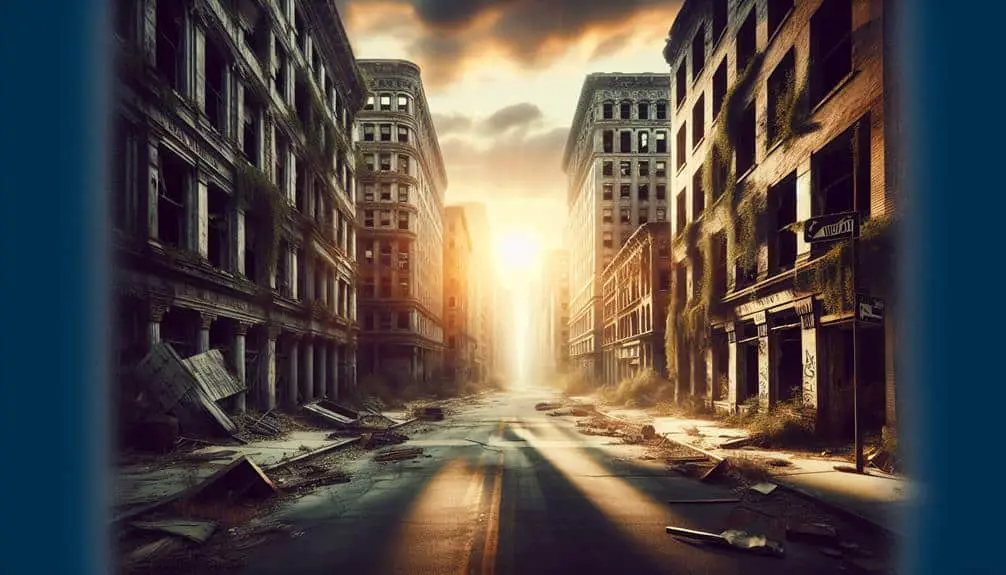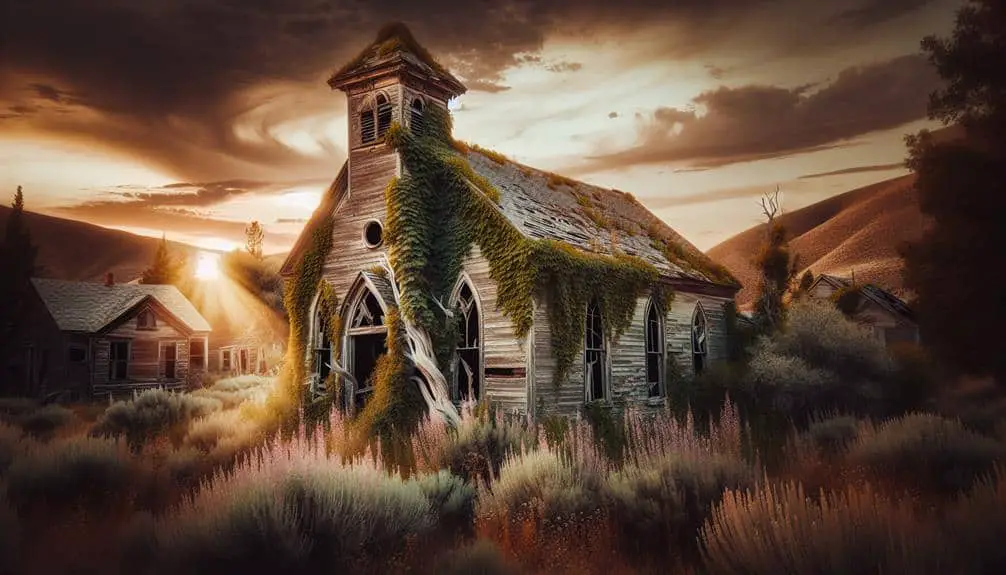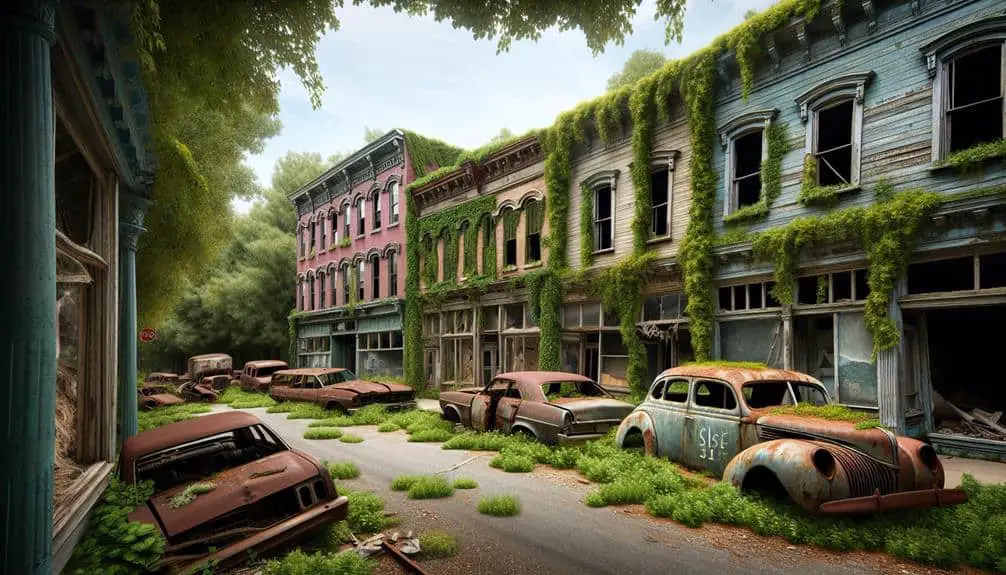Discover the eerie beauty of post-apocalyptic ghost town ruins in the US. Bodie, California, offers well-preserved decay, while Jerome, Arizona, boasts a historic copper mining town atmosphere. Explore these locations to witness the resilience and stories of past inhabitants. Gear up with a headlamp, safety gloves, and a camera with low-light capabilities for urban exploration. Stay safe by watching for hazards, wearing sturdy footwear, and informing a trusted person of your plans. Embrace the allure of decaying landscapes through photography and editing techniques that intensify the haunting atmosphere. Uncover the unique tales of desolation waiting to be captured.
Key Points
- Choose iconic locations like Bodie, California, for authentic post-apocalyptic visuals.
- Utilize low-light photography techniques to capture the eerie ambiance of abandoned ruins.
- Incorporate elements of decay like peeling paint and overgrown vegetation for authenticity.
- Experiment with editing to enhance the desolate and haunting atmosphere of ghost town ruins.
- Focus on storytelling through images to convey the history and mystery of post-apocalyptic landscapes.
Best Ghost Towns for Photography
When exploring the best ghost towns for photography, consider the unique charm and historical significance each location offers to capture stunning images. The United States boasts top locations like Bodie, California, a well-preserved ghost town that was once a thriving gold-mining hub. Its dilapidated buildings and dusty streets provide a mesmerizing glimpse into the past, perfect for evocative photographs that tell a story of bygone days.
Another must-visit is Jerome, Arizona, known for its picturesque setting on Cleopatra Hill and its fascinating history as a copper mining town. Capture the essence of the Old West with images of the town's steep streets and historic buildings.
These ghost towns hold immense historical significance, offering a window into a time long gone. Each location tells a unique tale of boom and bust, showcasing the resilience and adaptability of the people who once inhabited these now-desolate streets. Photographing these ghost towns allows you to freeze moments in time and preserve the legacy of these once-thriving communities for future generations to appreciate.
Essential Gear for Urban Exploration
Exploring deserted urban areas demands specific gear to ensure your safety, comfort, and ability to capture compelling images. When setting out on nighttime exploration of abandoned buildings, equipping yourself with the right tools is vital. Here are four essential items to enhance your urban exploration experience:
- Headlamp: A dependable headlamp is essential for maneuvering in dark and confined spaces in abandoned buildings. It keeps your hands free for climbing or taking photos.
- Safety Gloves: Durable gloves protect your hands from sharp objects, debris, or hazardous materials you may encounter while investigating these abandoned structures.
- Camera with Low-Light Capabilities: To capture the eerie beauty of abandoned buildings at night, a camera with exceptional low-light performance is indispensable. It allows you to document the haunting atmosphere in high-quality images.
- First Aid Kit: In case of minor injuries or accidents during your exploration, having a compact first aid kit can provide essential medical assistance until help arrives. Prioritize safety and preparedness to make the most of your urban exploration adventures.
Safety Tips for Exploring Abandoned Areas
For a secure and successful exploration of abandoned areas, prioritizing safety measures is vital. When venturing into these mysterious and often hazardous places, it's essential to be aware of the potential dangers that abandoned buildings can pose. From unstable structures to hidden debris and hazardous materials, abandoned building dangers are numerous and can be life-threatening if not approached with caution.
To guarantee a safe urban exploration experience, there are essential precautions to keep in mind. Always wear sturdy footwear to protect your feet from sharp objects and unstable surfaces. Additionally, carrying a flashlight and a first aid kit can be lifesaving in case of emergencies. It's also advisable to inform someone trustworthy about your exploration plans and to never venture into abandoned areas alone.
Capturing the Essence of Decay
To truly capture the essence of decay in abandoned areas, one must observe the gradual erosion of time through intricate details and subtle transformations. When exploring these haunting landscapes, pay attention to the decaying beauty that lies within:
- Peeling Paint: Notice how the once vibrant colors now peel and flake, revealing the raw materials beneath, a proof of the passage of time.
- Cracked Structures: Look for cracks snaking through walls and ceilings, evidence of the structural integrity succumbing to the forces of nature.
- Overgrown Vegetation: Witness how nature reclaims its territory, with vines creeping through broken windows and plants sprouting from every crevice.
- Rusty Relics: Discover the allure of rusted metal objects, each layer of corrosion telling a story of neglect and abandonment.
In these moments of decay, there's a unique beauty that emerges, a reminder of the impermanence of all things. Embrace the melancholic charm of these decaying landscapes as you capture their essence through your lens.
Editing Tips for Eerie Atmosphere
Enhance the eerie atmosphere of your post-apocalyptic ghost town photographs through strategic editing techniques that amplify the haunting allure of decay. To create tension and evoke haunting aesthetics, start by adjusting the contrast. Darkening the shadows and increasing the highlights can intensify the sense of desolation and mystery in your images. Experiment with desaturation to give your photos a more ominous and ghostly feel. By reducing the vibrancy of colors, you can enhance the sense of abandonment and isolation that permeates these forgotten landscapes.
Another editing tip is to play with textures. Adding grain or noise to your photos can simulate the gritty, rough textures often associated with decaying structures, adding depth and realism to your compositions. Additionally, consider incorporating subtle vignetting to draw the viewer's focus towards the center of the frame, creating a sense of unease and confinement within the vast emptiness of the ghost town.
Frequently Asked Questions
Are There Any Legal Ramifications for Exploring and Photographing Ghost Town Ruins in the Us?
Wondering about the legal side of exploring and photographing ghost town ruins in the US? Remember, laws vary by location. Respect private property rights, historical sites, and nature. Always research local regulations before venturing out.
How Do Photographers Ensure That They Are Respecting the History and Memory of the Communities That Once Inhabited These Abandoned Areas?
To respect communities and preserve history while photographing ghost town ruins, guarantee consent when possible, research the area's significance, leave artifacts untouched, and share stories responsibly. Honor the past through mindful documentation and storytelling.
What Are Some Unexpected Challenges That Photographers May Face When Trying to Capture the Essence of Decay in Ghost Town Ruins?
When capturing decay in ghost town ruins, challenges like lighting, access restrictions, and unstable structures may hinder your composition techniques. Adapting to these obstacles creatively can lead to unique and powerful photographs. Experimentation is key.
Are There Any Specific Techniques or Considerations for Capturing the Unique Atmosphere of Post-Apocalyptic Ghost Town Ruins During Different Times of Day or Weather Conditions?
When capturing the unique atmosphere of post-apocalyptic ghost town ruins, consider lighting effects and composition techniques for different times of day and weather conditions. Embrace the challenge to create compelling visuals that tell a haunting story.
When maneuvering ethical dilemmas around profiting from images in abandoned areas, consider the impact on local communities, respect property rights, and seek permission when possible. Let creative inspiration drive you to tell stories responsibly.



